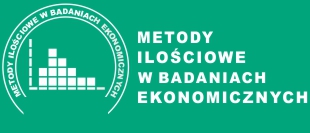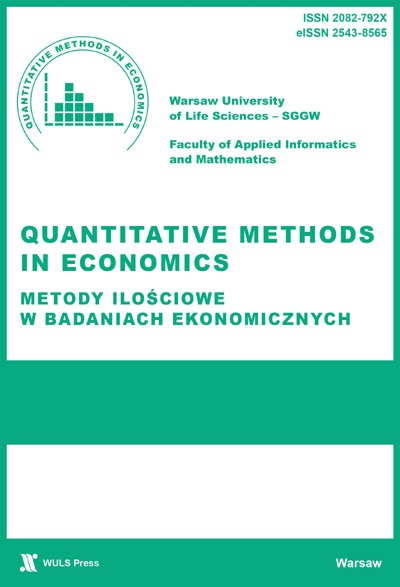Main Article Content
In this paper, we study the differences between forecasts obtained with the classical seasonal ARIMA model and forecasts obtained with the neural network model called iTransformers. The analysis is done on Polish data concerning preterm birth from 2015 to 2020. We compare the results and calculate the effect size to conclude the impact of the obtained differences.
Article Details
Ahmed S., Nielsen I.E., Tripathi A. et al. (2023) Transformers in Time-Series Analysis: A Tutorial. Circuits Syst Signal Process 42, 7433-7466, https://doi.org/10.1007/s00034-023-02454-8. (Crossref)
Aijaz I., Agarwal P. (2019) A Study on Time Series Forecasting using Hybridization of Time Series Models and Neural Networks. Recent Patents on Computer Science, 12(5), 827-832, https://doi.org/10.2174/1573401315666190619112842. (Crossref)
Borboa-Olivares H., Rodríguez-Sibaja M.J., Espejel-Nuñez A., Flores-Pliego A., Mendoza-Ortega J., Camacho-Arroyo I., González-Camarena R., Echeverría-Arjonilla J.C., Estrada-Gutierrez G. (2023) A Novel Predictive Machine Learning Model Integrating Cytokines in Cervical-Vaginal Mucus Increases the Prediction Rate for Preterm Birth. International Journal of Molecular Sciences, 24(18), 13851, https://doi.org/10.3390/ijms241813851. (Crossref)
Box G., Jenkins G. (1970) Time Series Analysis: Forecasting and Control. Holden-Day, San Francisco.
Brandon D., McGrath J. (2016) Infant Mortality Rates and Preterm Birth: A Challenge for Advocacy. Advances in Neonatal Care, 16(5), 323-324, https://doi.org/10.1097/ANC.0000000000000344. (Crossref)
Dench D., Joyce T., Minkoff H. (2022) United States Preterm Birth Rate and COVID-19. Pediatrics, 149(5), https://doi.org/10.1542/peds.2021-055495. (Crossref)
Gemmill A., Casey J. A., Catalano R., Karasek D., Margerison C. E., Bruckner T. (2022) Changes in Preterm Birth and Caesarean Deliveries in the United States during the SARS-CoV-2 Pandemic. Paediatric and Perinatal Epidemiology, 36(4), 485-489, https://doi.org/10.1111/ppe.12811. (Crossref)
Lakens D. (2013) Calculating and Reporting Effect Sizes to Facilitate Cumulative Science: a Practical Primer for T-Tests and ANOVAs. Frontiers in Psychology, 4, 863. https://doi.org/10.3389/fpsyg.2013.00863. (Crossref)
Lim B., Zohren S. (2021) Time-Series Forecasting with Deep Learning: a Survey. Phil. Trans. R. Soc. A, 379: 20200209, https://doi.org/10.1098/rsta.2020.0209 (Crossref)
Liu Y., Hu T., Zhang H., Wu H., Wang S., Ma L., Long M. (2023) Itransformer: Inverted Transformers Are Effective for Time Series Forecasting. arXiv preprint arXiv: 2310.06625.
Miller J. A., Aldosari M., Saeed F., Barna N. H., Rana S., Arpinar I. B., Liu N. (2024) A Survey of Deep Learning and Foundation Models for Time Series Forecasting. arXiv preprint arXiv:2401.13912.
Priya T., Sarkar B. K., Sahana S. K. (2024) Regression based Machine Learning Models for Forecasting Preterm Birth Cases. Procedia Computer Science, 235, 830-839, https://doi.org/10.1016/j.procs.2024.04.079. (Crossref)
Sefidkar R., Zayeri F., Kazemi E., Salehi M., Dehnad A., Hafizi M. (2021) A Trend Study of Preterm Infant Mortality Rate in Developed and Developing Countries over 1990 to 2017. Iranian Journal of Public Health, 50(2), 369-375, https://doi.org/10.18502/ijph.v50i2.5353. (Crossref)
Tzitiridou-Chatzopoulou M., Zournatzidou G., Kourakos M. (2024) Predicting Future Birth Rates with the Use of an Adaptive Machine Learning Algorithm: A Forecasting Experiment for Scotland. International Journal of Environmental Research and Public Health, 21(7), 84, https://doi.org/10.3390/ijerph21070841. (Crossref)
Vaswani A., Shazeer N., Parmar N., Uszkoreit J., Jones L., Gomez A., Kaiser L., Polosukhin I. (2017) Attention Is All You Need. NeurIPS, 2017.
Wen Q., Zhou T., Zhang C., Chen W., Ma Z., Yan J., Sun L. (2022) Transformers in Time Series: A Survey. arXiv preprint arXiv:2202.07125. (Crossref)
Yu Q. Y., Lin Y., Zhou Y. R., Yang X. J., Hemelaar J. (2024) Predicting Risk of Preterm Birth in Singleton Pregnancies using Machine Learning Algorithms. Frontiers in Big Data, 7, https://doi.org/10.3389/fdata.2024.1291196. (Crossref)
Zeng A., Chen M., Zhang, L., & Xu, Q. (2023). Are Transformers Effective for Time Series Forecasting?. Proceedings of the AAAI Conference on Artificial Intelligence, 37(9), 11121-11128, https://doi.org/10.1609/aaai.v37i9.26317. (Crossref)
Zhang F., Tong L., Shi C., Zuo R., Wang L. Wang Y. (2024) Deep Learning in Predicting Preterm Birth: A Comparative Study of Machine Learning Algorithms. Maternal-Fetal Medicine, 6(3), 141-146, https://doi.org/10.1097/FM9.0000000000000236. (Crossref)
Zhang Y., Du S., Hu T., Xu S., Lu H., Xu C., Li J., Zhu X. (2023) Establishment of a Model for Predicting Preterm Birth based on the Machine Learning Algorithm. BMC Pregnancy and Childbirth, 23(1), 779, https://doi.org/10.1186/s12884-023-06058-7. (Crossref)
Downloads
- Urszula Grzybowska, Ludwik Wicki, Wykorzystanie metody DEA do analizy zmian produktywności i efektywności w zakresie produkcji zbóż według województw w latach 1997-2019 , Metody Ilościowe w Badaniach Ekonomicznych: Tom 23 Nr 4 (2022)
- Bolesław Borkowski, Marek Karwański, Wiesław Szczesny, PORÓWNANIE SKUTECZNOŚCI DWÓCH KULTUR ANALITYCZNYCH , Metody Ilościowe w Badaniach Ekonomicznych: Tom 22 Nr 4 (2021)
- Urszula Grzybowska, Marek Karwański, Selekcja zmiennych metodami statystycznymi i uczenia maszynowego. Porównanie podejść na przykładzie danych finansowych , Metody Ilościowe w Badaniach Ekonomicznych: Tom 24 Nr 4 (2023)
- Urszula Grzybowska, Marek Karwański, Effectiveness of Variable Selection Methods for Machine Learning and Classical Statistical Models , Metody Ilościowe w Badaniach Ekonomicznych: Tom 25 Nr 2 (2024)
- Marek Karwański, Krzysztof Zmarzłowski, MODELE PROGNOZ EKONOMETRYCZNYCH , Metody Ilościowe w Badaniach Ekonomicznych: Tom 16 Nr 4 (2015)
- Marek Karwański, Urszula Grzybowska, APPLICATION OF L-MOMENTS IN HOMOGENEITY EXAMINATION FOR GROUPS OF PRODUCTION COMPANIES DISTINGUISHED BY DEA , Metody Ilościowe w Badaniach Ekonomicznych: Tom 18 Nr 3 (2017)
- Urszula Grzybowska, Marek Karwański, Wykorzystanie miar matematycznych i biznesowych do porównania modeli macierzy migracji stosowanych w analizie ryzyka kredytowego , Metody Ilościowe w Badaniach Ekonomicznych: Tom 12 Nr 2 (2011)
- Urszula Grzybowska, Marek Karwański, APPLICATION OF MIXED MODELS AND FAMILIES OF CLASSIFIERS TO ESTIMATION OF FINANCIAL RISK PARAMETERS , Metody Ilościowe w Badaniach Ekonomicznych: Tom 16 Nr 1 (2015)
- Urszula Grzybowska, Marek Karwański, APPLICATION OF MIGRATION MATRICES TO RISK EVALUATION AND THEIR IMPACT ON PORTFOLIO VALUE , Metody Ilościowe w Badaniach Ekonomicznych: Tom 14 Nr 1 (2013)
- Urszula Grzybowska, Marek Karwański, FAMILIES OF CLASSIFIERS – APPLICATION IN DATA , Metody Ilościowe w Badaniach Ekonomicznych: Tom 15 Nr 2 (2014)

Utwór dostępny jest na licencji Creative Commons Uznanie autorstwa – Użycie niekomercyjne 4.0 Międzynarodowe.
Publikowane artykuły dostępne są na warunkach Open Access na zasadach licencji Creative Commons CC BY-NC – do celów niekomercyjnych udostępnione materiały mogą być kopiowane, drukowane i rozpowszechniane. Autorzy ponoszą opłatę za opublikowanie artykułu.





